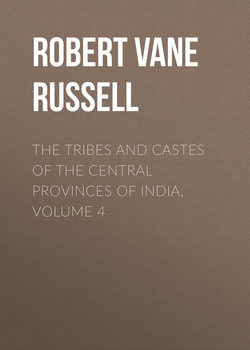Читать книгу The Tribes and Castes of the Central Provinces of India, Volume 4 - Robert Vane Russell - Страница 110
Part II
Articles on Castes and Tribes
Kumhār—Yemkala
Vol. IV
Mahār
2. Length of residence in the Central Provinces
ОглавлениеSeveral circumstances indicate that the Mahār is recognised as the oldest resident of the plain country of Berār and Nāgpur. In Berār he is a village servant and is the referee on village boundaries and customs, a position implying that his knowledge of them is the most ancient. At the Holi festival the fire of the Mahārs is kindled first and that of the Kunbis is set alight from it. The Kāmdār Mahār, who acts as village watchman, also has the right of bringing the toran or rope of leaves which is placed on the marriage-shed of the Kunbis; and for this he receives a present of three annas. In Bhandrā the Telis, Lohārs, Dhimārs and several other castes employ a Mahār Mohturia or wise man to fix the date of their weddings. And most curious of all, when the Panwār Rājpūts of this tract celebrate the festival of Nārāyan Deo, they call a Mahār to their house and make him the first partaker of the feast before beginning to eat themselves. Again in Berār114 the Mahār officiates at the killing of the buffalo on Dasahra. On the day before the festival the chief Mahār of the village and his wife with their garments knotted together bring some earth from the jungle and fashioning two images set one on a clay elephant and the other on a clay bullock. The images are placed on a small platform outside the village site and worshipped; a young he-buffalo is bathed and brought before the images as though for the same object. The Patel wounds the buffalo in the nose with a sword and it is then marched through the village. In the evening it is killed by the head Mahār, buried in the customary spot, and any evil that might happen during the coming year is thus deprecated and, it is hoped, averted. The claim to take the leading part in this ceremony is the occasion of many a quarrel and an occasional affray or riot Such customs tend to show that the Mahārs were the earliest immigrants from Bombay into the Berār and Nāgpur plain, excluding of course the Gonds and other tribes, who have practically been ousted from this tract. And if it is supposed that the Panwārs came here in the tenth century, as seems not improbable,115 the Mahārs, whom the Panwārs recognise as older residents than themselves, must have been earlier still, and were probably numbered among the subjects of the old Hindu kingdoms of Bhāndak and Nagardhan.
114
Kitts’ Berār Census Report (1881), p. 143.
115
See article on Panwār Rājpūt.
